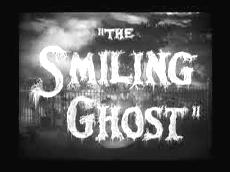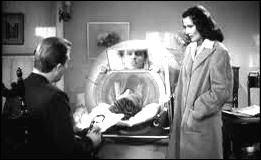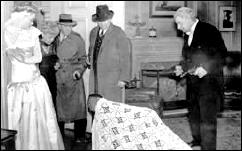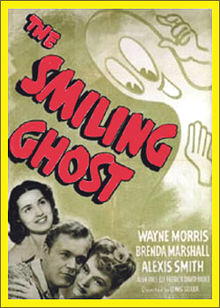Sat 13 Aug 2011
A Movie Review by Walter Albert: THE SMILING GHOST (1941).
Posted by Steve under Mystery movies , Reviews[9] Comments

THE SMILING GHOST. Warner Brothers, 1941. Wayne Morris, Brenda Marshall, Alexis Smith, Alan Hale, Lee Patrick, David Bruce, Helen Westley, Willie Best. Screenplay by Kenneth Garnet and Stuart Palmer, based on a story by Stuart Palmer. Director: Lewis Seiler.
I saw this spooky comic mystery on its initial release, when I was still in short pants, and for years the image of the Ghost, glowing eerily in the dark, haunted my dreams. A recent screening by Turner didn’t, perhaps, chill me in the way the original release did, but it’s still an engaging Old House mystery, with the requisite dose of sliding panels and screams in the night.
When out-of-work Alexander “Lucky” Dowling (Wayne Morris), besieged by debt collectors, is hired to play the role of the fiancé of heiress Elinor Bentley (Alexis Smith) for a month, he accepts the job without realizing previous suitors have been severely injured in a suspicious car crash and poisoned by the bite of a venomous snake.

Accompanied by his valet Clarence (Willie Best), Lucky moves into the Bentley house (it’s a bit too small to be called a mansion) where very quickly an attempt is made on his life and he realizes the job is a potentially lethal one.
Lucky is slower on the uptake than Clarence but he quickly buys into the fiction that Elinor truly loves him, a fiction that is eventually dispelled by the more clear-headed perspective of reporter Lil Barstow (Brenda Marshall), but not before his devotion is put to the ultimate test, which could be either marriage to the predatory Elinor or murder at the hands of the Ghost.

The household is crowded with members of the Bentley clan, headed by matriarch Helen Westley, with Charles Hulton giving an indelible portrait of a professor whose hobby is not only collecting shrunken heads but actually producing them in his laboratory. Alan Hale bumbles around as a general factotum and security detail, and Lee Patrick sizes up the situation with her usual wry humor.
Willie Best, in these supposedly enlightened times, gives probably the most controversial performance, with the most offensive (and, dare I say it, funniest) moment taking place when he conceals himself in a coal bin in the basement.
This is probably not quite in the league of Paramount’s Old House classics, The Cat and the Canary and The Ghost Breakers, but it kept breaking me up and occasionally produced a hint of the chills that captivated me at a long-ago Saturday matinee. And noting the name of a noted concoctor of comic mysteries as a co-author of the script, I suspect that he’s responsible for the more delightful comic notes in the screenplay.

August 13th, 2011 at 5:26 pm
In the category of “old spooky house” mysteries, this is a good one.
Question: Do old spooky house mysteries have to be comedies to fall into the category?
Question: Has anyone made a list of all of the old spooky house mysteries?
Comment: There are a lot of them available from Sinister Cinema, among other outlets.
THE SMILING GHOST itself is available on DVD from Warner Archives, paired up with FIND THE BLACKMAILER.
August 15th, 2011 at 10:29 am
Since most people’s acquaintance with this category of films begins with the Bob Hope/Paulette Goddard “Cat and the Canary,” which is certainly a spooky comedy, this is a good question to ask.
Both the silent and first sound versions (I’ve not seen the later remakes) of “Cat and the Canary” have comic elements. The comic characters are often servants (as in “The Cat Creeps”) while in the undoubted classic of the genre, James Whale’s “The Old Dark House,” the darkly eccentric characters raise comedy to a sophisticated level that’s unmatched in any other spooky house films that I can think of offhand. Although, in Carl Dreyer’s “Vampyr,” the line between dark comedy and sinister thrills is a very narrow one that some might argue is sometimes breached.
I’m not aware of any comprehensive listing of the films in this category, but it may very well have been done in some fan publication that I’ve not seen. Not that you raise the question, Steve, I think that googling is in order.
And the list should certainly contain many of the silent and sound serials where masked villains and dark, dangerous mansions were a much-loved feature of those cherished episodic films.
August 15th, 2011 at 11:08 am
I think I might as well go ahead and call the category “old spooky house comedy mysteries.” I think that makes it clear what the category consists of, without any more definition than that. And no matter how specific you try to be with a concise definition, there’ll always be the borderline cases that one side will say should go in and the other won’t.
Googling is a good idea. I haven’t found a list yet after doing only a brief search, but it has brought up a number of individual entries.
One source in particular seems to be heading in the right direction, though. I’ll quote a long paragraph that adds to the history of the category:
http://scaredsillybypaulcastiglia.blogspot.com/2010/01/old-dark-anachronism.html
The classic “Old Dark House†horror-comedy-mysteries all tend to derive from the following sources: the 1913 novel “Seven Keys to Baldpate†(which formed the basis of several movies including the 1986 Gene Wilder/Gilda Radner horror-comedy “Haunted Honeymoonâ€) by Earl Derr Biggers (creator of Charlie Chan), the 1927 novel “Benighted†by J.B. Priestley (which yielded the 1932 classic movie “The Old Dark House†and the 1963 not-so-classic movie “The Old Dark Houseâ€), and the plays “The Bat†from 1920 by Mary Roberts Rinehart (filmed with Chester Morris as “The Bat Whispers†in 1926 and again in 1959 with its original title as a Vincent Price chiller), “The Cat & the Canary” from 1926 by John Willard (also made into several films including the classic 1939 Bob Hope/Paulette Goddard horror-comedy), and “The Gorilla†by Ralph Spence (filmed as a horror-comedy vehicle for The Ritz Brothers and inspiring the Hugh Herbert/Allen Jenkins horror-comedy, “Sh! The Octopus!â€). All feature some combination of the familiar hallmarks of the genre – hidden passageways, suspicious servants, old creaky houses, etc. And all contain a lot of humor. Coming a little late to the party but adding the final template was the 1939 Joseph Kesserling play “Arsenic & Old Lace†with Boris Karloff (and its 1944 spin-off film with Raymond Massey).
More later, if and when I have some more free time on my hands…!
August 15th, 2011 at 11:11 am
Interestingly enough, or at least it is to me, when I googled
[“old spooky house†mystery movies]
the first site that came up is this one.
Your results may vary.
August 15th, 2011 at 11:56 am
I googled and came up with an SF site that had a list of feature films (“The Smiling Ghost” was not included), I didn’t have time to work my way through this and will return to it.
I suppose that “Arsenic and Old Lace” is a marginal entry as an old house with eccentric murderous inhabitants (but, of course, this could also define the Whale classic). I must confess that in spite of some good performances (notably those of Josephine Hull, Jean Adair, and John Alexander), I’ve always found that Cary Grant was unwatchable in his spastic overacting, and Raymond Massey was a major disaster. If only Karloff had reprised his stage role! This bit of miscasting goes down in my black ledger with the casting of non-dancer Eddie Albert in the lame film version of the great Rodgers & Hart musical “On Your Toes.”
August 15th, 2011 at 2:40 pm
What I can’t figure about this film is that the story, allegedly by Kenneth Garnet and Stuart Palmer, was one used by Universal before and afterwards for films like SECRET OF THE BLUE ROOM (’33) THE MISSING GUEST (’38) and MURDER IN THE BLUE ROOM (’44… with music by “The JazzyBelles”.) So how did it turn up at Warners?
Also, leading man Wayne Morris always looked like a big sloppy handful of nothing much, but he became a bona-fide war hero, downing 7 Japanese planes and contributing to the sinking of 5 enemy ships… after which he returned to films like PATHS OF GLORY and 2 GUNS & A BADGE.
August 16th, 2011 at 1:07 pm
Only with great reluctance do I forego this cheesecake shot of Marshall in the links list…
http://1.bp.blogspot.com/-Tv9bbB4uGiE/TejwkpAovyI/AAAAAAAAKww/IqPdeLyOvz8/s1600/Brenda+Marshall3.jpg
August 16th, 2011 at 1:18 pm
You can now see which of the two women in his life Wayne Morris’s character chose, and why.
Thanks, Todd!
February 14th, 2012 at 9:16 pm
Steve – thank you for mentioning my “Scared Silly” project. I should be be posting my review of “The Ghost Breakers” within the next week and a half. Interested folks can visit my site at http://scaredsillybypaulcastiglia.blogspot.com and refer to the alphabetical listing of reviews posted to date on the right-hand side of the page.
Walter Albert – do you remember the SF website you came upon that had a listing of spooky old dark house comedy-mysteries, and if so, can you please post the URL? Thank you.